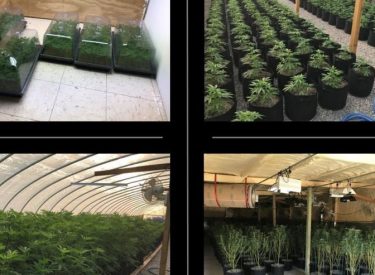Medical Marijuana Industry Creates Booming Impact on Rural Oklahoma
News-5, Shelby Cashman - May 24, 2022 7:08 am

HUGHES COUNTY, Okla. —
Rural Oklahoma has seen the impacts of the booming medical marijuana industry.
Oklahoma has come to be known as the “Wild West of Weed” thanks to the booming medical marijuana industry. While grow operations have been popping up all across the state, it is rural Oklahoma that has felt the impact.
Some said the infrastructure in place is not equipped to handle the influx. Others said it is the new frontier.
If you drive down Route 77, you can’t miss the iconic Oklahoma landmark the VW Spider Bug in Lexington. Built in the early 1970s, it has always been surrounded by two things woven into the fabric of rural Oklahoma: farms and churches.
In a sign of the times, perhaps a part of the new Oklahoma, its once holy neighbor is now a medical marijuana grow operation.
“We originally were looking at Colorado, but when Oklahoma went legal, we pretty much uprooted all of our kids and moved to Oklahoma to kind of start over,” said Josh Blevins, owner and CEO of Twisted Roo.
It’s a story you’ll hear from many, chasing a dream and a profit in the Sooner State. It will cost thousands of dollars less to get started here.
“Initial business license property, I mean everything,” Blevins said.
It’s the low barriers of entry that came together to form a green wave once medicinal marijuana became legal in 2018 here. However, was rural Oklahoma ready?
“This legalized in the next thing you know, you wake up and they’re popping up like popcorn,” said Sheldon Tatum, Hughes County Rural Water Manager.
Tatum is the rural water manager in Hughes County with a population of just over 13,000.
Tatum said there are about eight large grow operations in his territory that can each average up to a quarter of a million gallons of water usage a month. While many use wells on their property, he worries his 560 residential customers could end up shouldering the cost of the overall increased demand.
“Just to just to drill a new well now for us you’re probably looking at close to three-quarters of a million dollars,” Tatum said.
Another issue, Tatum said, is aging infrastructure.
“It takes often a couple of years for us to even put the wheels in motion for funding to upgrade pumps or anything to that nature, ” Tatum said.
The delicate plants don’t just need water to stay alive. They also need light.
“We spent a ton of money upfront to run LED light fixtures,” Blevins said.
Air conditioning and the right amount of humidity are things that require a large amount of electricity.
“Our monthly bills in the summer are about five to six grand,” Blevins said.
That may sound like a lot but, what effect does a high energy user, like a large grow, have on everyone else’s electricity? The answer may be surprising.
“In general, these growers are very good for the grid,” said Logan Pleasant, director of engineering at Lake Region Electric Cooperative.
Pleasant is the director of engineering and operations at the Lake Region Electric Cooperative serving parts of seven Oklahoma counties, He said grows are beneficial because they don’t fluctuate as often, as say an electric car charger.
They are consistent and reliable.
“And then when they do come on, they tend to come on and stay on and that type of load is the holy grail of load for the grid,” Pleasant said.
With around 200 grows in his jurisdiction so far, he said things have been running smoothly. They’ve been allowed to attach to the power grid with no major disruptions.
“If their load continues to grow and system upgrades are required, then at that point, we’ll go to them and ask for monetary input for those investments,” Pleasant said.
It is a scenario already playing out over in Lexington at Twisted Roo.
“We’re in a position on a new building that we built that we’re having to wait till August to get really any kind of power out there because they have to update their substation,” Blevins said.
In the meantime, they said they are doing what they can to be good stewards of the environment.
“This industry creates so much trash,” Blevins said.
In a market that has become increasingly saturated, Blevins said the industry in Oklahoma is at a turning point.
“I think there was definitely a point where you needed to recognize that that market was going to happen and the saturation was going to happen to make decisions and changes in your the way you’re doing business to sustain,” Blevins said.
For them, sustaining business has meant looking to be more environmentally friendly.
“We’ve been working with solar panel companies to try to figure out a way to utilize that type of energy,” Blevins said.
The upfront cost is expensive and with so much competition, prices are going down which means so are profits.
“When the market does drop down like this, people tend to forget about that issue. And what can they just utilize for the time being,” he said.
Nearly 387,000 Oklahomans have their medicinal marijuana license, according to data from the medical marijuana authority. That is about 10% of Oklahoma’s population.



